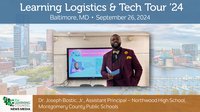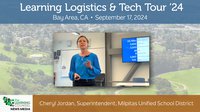Classroom technology adoption is at a tipping point. Fewer educators are asking what new EdTech can be added, and instead are asking what’s the right edtech to add. As the number of 1:1 device environments rises, so do the stakes of finding the answer. To navigate the existing challenges and find the right EdTech, district and school leaders can use the acronym LEAPS.
The LEAPS framework guides tool decisions based on Learning Environment, Accessibility, Personalization, and Students’ physical and emotional development. In making these choices, educators will have to address one basic challenge: most tools integrated into the classroom are not designed with students or education in mind. The lack of education-first tools leaves district leaders stuck having to repurpose existing technology that was designed for adults.
Students feel the impact of adult-centric technology. EdTech with the wrong fit can cause student frustration, disengagement, or physical discomfort. The latter is already happening. According to a survey conducted by Logitech and Education Week, 74 percent of educators say students’ level of physical comfort while using educational technology impacts their level of engagement in learning. In the same survey, 28 percent of secondary school teachers said their students experience neck, back, and/or wrist pain or fatigue while using edtech.
How to Choose the Right EdTech
There are solutions, however, and LEAPS can serve as the strategic framework for making choices. Here are the points to consider when selecting classroom technology.
● Choose Tools Designed for the Learning Environment
No matter how learning is taking place, a lot can happen during a school day. Add technology challenges to the mix and there is a greater risk of student distraction and disengagement. From intuitive tools that require little to no setup to long-lasting batteries, educators should look for products that they know will “just work” and avoid the potential of tech-related burnout.
It’s important that tools keep working. Compared to other industries, there is a greater need in education for technology that is durable, cleanable, and connectable to multiple devices. Emphasizing these features in edtech searches can help ensure educators find a tool that fits with the unique dynamics of a classroom.
● Prioritize Accessibility
While technology can provide many benefits to students, having the tools is only the start. Giving all students access to the same technology does not always translate into all student needs being met. Individual student abilities should still be considered. The right EdTech tools can alleviate the challenges. For example, research has shown that digital writing using an iPad significantly improves spelling accuracy and increases the number of ideas students with learning disabilities express.
The difference between having tools for all students and having the right tools for all students starts with accessible design. Tools that involve the voice of students with adaptive needs in the design process are particularly helpful in supporting success for all students.
● Build an EdTech ‘Pencil Case’ That Enables Personalization
When choosing the right tools, finding EdTech that gives students the chance to express their knowledge in their own learning style can enable greater personalization. The straightest path is to incorporate student voice and choice into tech selection and implementation. Districts and schools can:
● Collect student input about tools selected for a district or a school. This can be as simple as asking students what makes their learning experience better.
● Using what students share about tools, build an edtech ‘pencil case,’ with a variety of tools that provide options for students.
● Offer students this set of pre-selected tools — for example, headsets, styluses, and mice — then let them choose what they would like to use for an individual project or lesson.
● Consider Student Development
Students are at different stages of physical maturity and motor skills development, which means products that are built for adults often cause frustration for students. EdTech used in classrooms needs to consider these growing minds and bodies — without it, students may experience pain, fatigue, and distraction.
In the Logitech and Education Week survey, teachers reported almost 50 percent of their students aren’t physically comfortable with the technology they use in the classroom. The volume of students’ voices, how they hold a stylus, where they tap on a screen, or how they use a mouse changes over time as they grow. Considering these factors will help all students and teachers see and be seen and hear and be heard to enable better interactions and more collaboration. It’s why physical comfort is such a key part of engaged learning environments. Select tools that are not only designed to be age appropriate but have also involved students in the design process.
Now is a great time for districts and schools to recalibrate their approach to selecting EdTech. The right EdTech for every classroom is out there. By using meaningful measurements, districts and school leaders can better evaluate products and find the tools that best support their students.
About the author
Madeleine Mortimore is the global education innovation and research lead for Logitech, where she leads research on ed-tech hardware to create products that holistically optimize learning and teaching. She holds a master of education from the Harvard University Graduate School of Education, where she launched an EdTech startup at the Harvard Innovation Lab.











